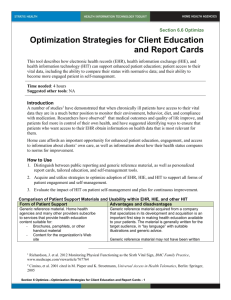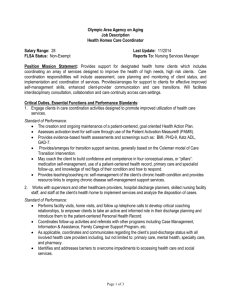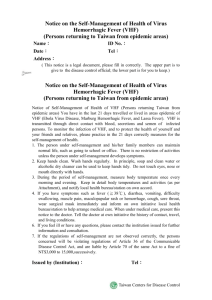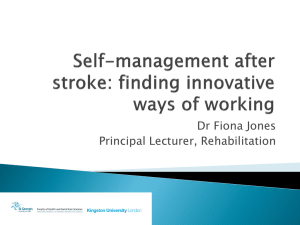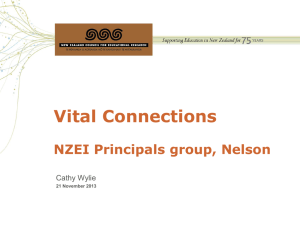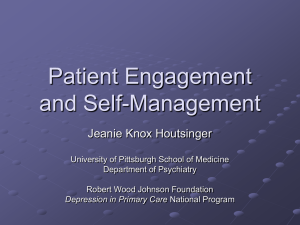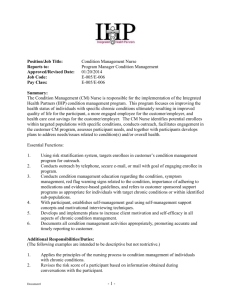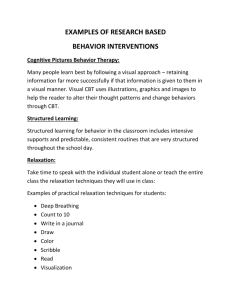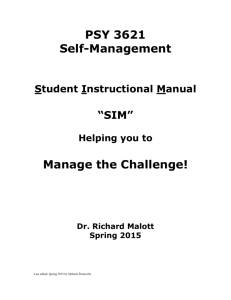6 Optimization Strategies for Client Education
advertisement
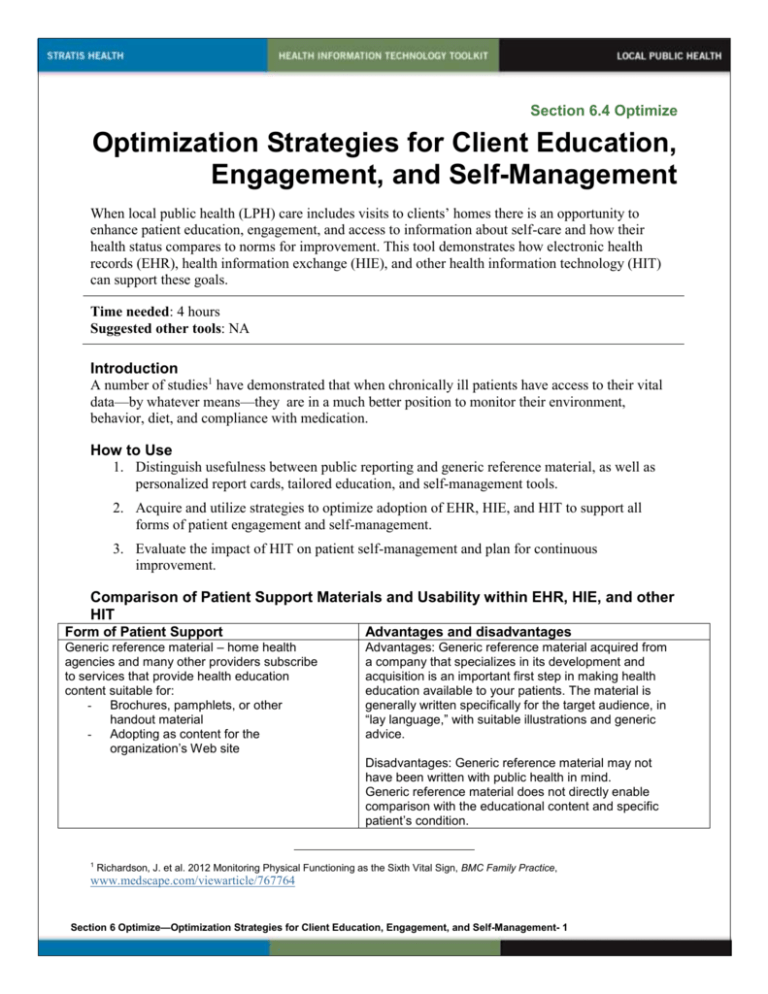
Section 6.4 Optimize Optimization Strategies for Client Education, Engagement, and Self-Management When local public health (LPH) care includes visits to clients’ homes there is an opportunity to enhance patient education, engagement, and access to information about self-care and how their health status compares to norms for improvement. This tool demonstrates how electronic health records (EHR), health information exchange (HIE), and other health information technology (HIT) can support these goals. Time needed: 4 hours Suggested other tools: NA Introduction A number of studies1 have demonstrated that when chronically ill patients have access to their vital data—by whatever means—they are in a much better position to monitor their environment, behavior, diet, and compliance with medication. How to Use 1. Distinguish usefulness between public reporting and generic reference material, as well as personalized report cards, tailored education, and self-management tools. 2. Acquire and utilize strategies to optimize adoption of EHR, HIE, and HIT to support all forms of patient engagement and self-management. 3. Evaluate the impact of HIT on patient self-management and plan for continuous improvement. Comparison of Patient Support Materials and Usability within EHR, HIE, and other HIT Form of Patient Support Advantages and disadvantages Generic reference material – home health agencies and many other providers subscribe to services that provide health education content suitable for: - Brochures, pamphlets, or other handout material - Adopting as content for the organization’s Web site Advantages: Generic reference material acquired from a company that specializes in its development and acquisition is an important first step in making health education available to your patients. The material is generally written specifically for the target audience, in “lay language,” with suitable illustrations and generic advice. Disadvantages: Generic reference material may not have been written with public health in mind. Generic reference material does not directly enable comparison with the educational content and specific patient’s condition. 1 Richardson, J. et al. 2012 Monitoring Physical Functioning as the Sixth Vital Sign, BMC Family Practice, www.medscape.com/viewarticle/767764 Section 6 Optimize—Optimization Strategies for Client Education, Engagement, and Self-Management- 1 Form of Patient Support Customizable educational material is available as a utility in some EHR systems. - Some systems enable the public health nurse to select specific educational material and have it print with the patient’s name, photo, language spoken, and even large font. - Some systems enable the public health nurse to combine educational material on multiple conditions for a single client or family so one unique packet of information can be provided to the patient. - Some systems pre-populate educational material selected by the public health nurse with patientspecific information, further customizing the material to the specific patient. Client-specific report cards and diaries (sometimes referred to as “participatory medicine”) are intended to motivate the client to partner with the public health nurse in improving his or her health, take an active role in self-management, participate in decisionmaking, and assume responsibility for making agreed-upon changes in behavior. Advantages and disadvantages Generic reference material—when distributed by a public health nurse—may require more explanation than customizable material. Advantages: Educational materials customizable through the EHR provide a closer bond between the material and the client, as well as specific guidance. To the extent that the client’s own information can be incorporated, the materials are more beneficial. The public health nurse can spend time focusing on specific messages rather than filling in client-specific information. Advantages: Client-specific diaries provide very specific, clear messages about the client’s health status and can be generated by some EHRs, especially when linked to an HIE organization (HIO) where multiple providers can contribute data (e.g., medications from pharmacy, lab results from commercial or public health lab, vital signs from public health nurse). Disadvantages: Client diaries may not include specific instructions for improvement. They must be explained to the client and/or family in a supportive, partnering manner. These should not be introduced as “grades” in school. The public health nurse using the diaries must be skilled in using them. See also: http://www.jopm.org/evidence/casestudies/2011/04/04/creating-a-participatory-officepractice-for-diabetes-care/attachment/shahady-table-1/ Motivational interviewing is a non-judgmental approach to increasing a patient’s awareness of the potential problems caused, consequences experienced, and risks faced as a result of a health-related behavior – especially those that contribute to chronic disease (e.g., diet, exercise) and behavioral disorders (e.g., drinking, isolation). Steps include involving client in talking about issues and establishing rapport, focusing on specific things the client wants to change, and allowing client to plan the specific steps to implement the desired change so that the client feels empowered to actuate the change. See also: Section 6 Optimize—Optimization Strategies for Client Education, Engagement, and Self-Management - 2 Form of Patient Support Advantages and disadvantages http://www.motivationalinterview.org/ Shared decision making tools involve a collaborative process that allows clients and providers to make health care decisions together, taking into account the best scientific evidence available as well as the patient’s values and preferences. This honors both the provider’s expert knowledge and the client’s right to be fully informed of all care options and potential harms and benefits. It is most applicable to major clinical decisions, such as whether to have a particular surgery, but is also effective for lifestyle changes. See also: http://www.informedmedicaldecisions.org/what -is-shared-decision-making/ Patient self-management/patient engagement tools Patient self-management/patient engagement tools often refer to technology used by a client or informal caregiver to manage health problems outside formal institutions. These tools can be accessed independently by a client, and can be provided by a public health nurse who also uses motivational interviewing and shared decision making to help clients address barriers to achieving their health goals (e.g., lose weight, stop smoking). Some EHRs offer templates to build a client’s selfmanagement plan of care. Patient education, diaries, and report cards are also helpful adjuncts. Increasingly, patient selfmanagement is being linked to the broader scope of care coordination in the chronic care model. See also: http://www.chcf.org/~/media/MEDIA%20LIBR ARY%20Files/PDF/P/PDF%20PatientSelfMan agementToolsOverview.pdf http://informedmedicaldecisions.org/wpcontent/uploads/2012/04/Patient_Engagement _What_Works_.3.pdf http://www.google.com/url?sa=t&rct=j&q=&esr c=s&frm=1&source=web&cd=4&ved=0CEkQF jAD&url=http%3A%2F%2Fwww.lphi.org%2FL PHIadmin%2Fuploads%2FPt-Engage-SelfMgt-Knox24859.ppt&ei=EXlxUsDNL8qQyAHWk4CYAg &usg=AFQjCNFsUt3qW7U12kKNVefKwvNDig4wQ&sig2=ahJt 3bYrA23Y1n5mUrWxnA http://healthinsight.org/Internal/events/05-2312/megalan_talk.pdf Section 6 Optimize—Optimization Strategies for Client Education, Engagement, and Self-Management - 3 Adoption and Evaluation of Patient Self-Management Results 1. Consider using a tool to plan and track how you aid client education and self-management. 2. At a minimum, list self-management techniques that your LPH department has or can readily acquire/develop. Provide training and encourage staff members to use these techniques. 3. Ideally, document for each patient what self-management technique was applied when. (Techniques may need to be reinforced with discussions, and some techniques may need to be repeated.) 4. Although it is unlikely that only one technique will be effective when there is a specific opportunity for improvement, it can be helpful to focus on a specific goal and document results. 5. Two examples—for different patients—are provided below. Add your own focus areas and techniques. SelfManagement Technique Date Initiated Baseline Data Results after __ Time Specific Instructions to Patient Results after __ Time Report Card May 2 Uncontrolled diabetes; goal: Hg A1c = 8 in 3 months Aug 5: Hg A1c = 8.2 Nov 3: Hg A1c = 7.4 May 8 PHQ = 9 (Has fluctuated between 7 and 9) Jun 12 PHQ = 8 -Use structured diabetic diary to record diet and blood sugars -Track Hg A1c values through PHR -Have client develop a self-care plan Diabetic diary PHR to receive lab results Depression Self-Care Action Plan Copyright © 2014 Stratis Health. Aug 14 PHQ = 7 Updated 01-01-14 Section 6 Optimize—Optimization Strategies for Client Education, Engagement, and Self-Management - 4
